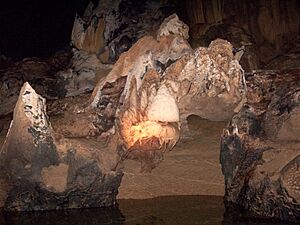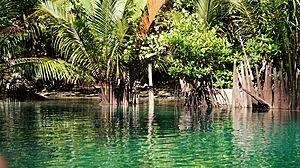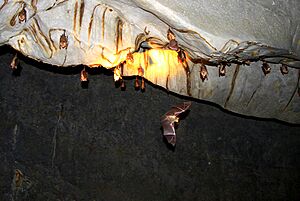Puerto Princesa Subterranean River National Park facts for kids
Quick facts for kids Puerto Princesa Subterranean River National Park |
|
|---|---|
|
IUCN Category III (Natural Monument)
|
|

Entrance to the Puerto Princesa Underground River
|
|
| Lua error in Module:Location_map at line 420: attempt to index field 'wikibase' (a nil value). | |
| Location | Palawan, Philippines |
| Nearest city | Puerto Princesa |
| Area | 22,202 hectares (54,860 acres) |
| Established | November 12, 1999 |
| Governing body | Department of Environment and Natural Resources City of Puerto Princesa |
| Type: | Natural |
| Criteria: | vii, x |
| Designated: | 1999 (23rd session) |
| Reference #: | 652rev |
| Region: | Asia-Pacific |
| Designated: | June 30, 2012 |
| Reference #: | 2084 |
The Puerto Princesa Subterranean River National Park is a special protected area in the Philippines. It is famous for its amazing underground river.
This park is found on the western coast of Palawan island. It's about 80 kilometers (50 mi) north of Puerto Princesa city. The park is home to the Puerto Princesa Subterranean River, also known as the Puerto Princesa Underground River. The local government of Puerto Princesa has taken care of the park since 1992.
The park was named a UNESCO World Heritage Site in 1999. In 2012, people voted it one of the New7Wonders of Nature. It also became a Ramsar Wetland Site in 2012, which means it's an important wetland for nature.
Many tourists visit this park. You can usually get there by driving to a village called Sabang. From there, small boats called Bangkas take visitors to the park entrance.
Contents
Discovering the Underground River
In 2010, a group of environmental experts and geologists made an exciting discovery. They found that the underground river has a "second floor" with small waterfalls inside the cave!
They also found a huge cave dome, about 300 m (980 ft) high, above the river. Inside, there were cool rock formations, large bats, and deep water holes. They even found more river channels and another deep cave. Marine creatures also live in these hidden parts. Some areas of the river are very hard to explore because there isn't enough oxygen.
On November 11, 2011, the Puerto Princesa Underground River was chosen as one of the New7Wonders of Nature. This was officially confirmed on January 28, 2012.
The Park's Landscape
The park is known for its limestone karst mountains. This means the landscape has unique rock formations shaped by water. The St. Pauls Underground River Cave is over 24 kilometres (15 mi) long. It includes an 8.2-kilometre-long (5.1 mi) underground part of the Cabayugan River.
The river flows through the cave and then directly into the West Philippine Sea. You can travel by boat up to 4.3 kilometres (2.7 mi) from the sea inside the cave. The cave has amazing stalactites (hanging from the ceiling) and stalagmites (growing from the floor). It also has several large rooms. One of these is the Italian's Chamber, which is 360-metre-long (1,180 ft) and one of the biggest cave rooms in the world.
The lower part of the river, up to six kilometres (3.7 mi) from the sea, is affected by ocean tides. For a long time, the Puerto Princesa Subterranean River was thought to be the longest underground river in the world. However, a longer one was found in Mexico in 2007.
This area is also very important for protecting different kinds of plants and animals. It has a complete ecosystem that goes from the mountains all the way to the sea. It also has some of the most important forests in Asia. UNESCO recognized it as a World Heritage Site on December 4, 1999.
Amazing Plants
The park has many different types of forests. In fact, it has thirteen of the forest types found in tropical Asia. These include forests on special soils, mountain forests, swamp forests, and mangrove forests near the coast.
Scientists have found over 800 different plant species here. These include at least 295 types of trees. Large trees like the dao (Dracontomelon dao), ipil (Intsia bijuga), and apitong (Dipterocarpus gracilis) are common in the lowland forests. Near the beach, you can find trees like bitaog (Calophyllum inophyllum). Other interesting plants include almaciga (Agathis philippinensis) and rattan (Calamus sp.).
Wonderful Animals
Birds are the most common animals in the park. Out of 252 bird species known in Palawan, 165 have been seen in the park. This means the park is home to 67% of all Palawan birds, including all 15 species that live only in Palawan. Some birds you might see are the blue-naped parrot (Tanygnathus lucionensis) and the Palawan hornbill (Anthracoceros marchei).
About 30 types of mammals have also been recorded here. The long-tailed macaque (Macaca fascicularis) is the only primate found in the area. You can often see them in the trees or feeding by the shoreline when the tide is low. Other mammals include the Palawan bearded pig (Sus ahoenobarbus) and the Palawan porcupine (Hystrix pumila).
The park also has 19 types of reptiles, with eight of them found only here. Common reptiles include large snakes like the common reticulated python (Python reticulates) and the monitor lizard (Varanus salvator). There are ten types of amphibians, like the Philippine woodland frog (Rana acanthi). One special frog, Barbourula busuangensis, lives only in Palawan and has been seen here.
Inside the cave, you can find nine types of bats and two types of swiftlets. In the coastal waters of the park, you might even spot a sea cow (Dugong dugon) or a hawksbill sea turtle (Chelonia mydas).
See also
 In Spanish: Parque nacional del río subterráneo de Puerto Princesa para niños
In Spanish: Parque nacional del río subterráneo de Puerto Princesa para niños
- List of World Heritage Sites in the Philippines
- List of national parks of the Philippines
- ASEAN Heritage Parks




